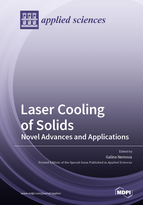Laser Cooling of Solids: Novel Advances and Applications
A special issue of Applied Sciences (ISSN 2076-3417). This special issue belongs to the section "Applied Physics General".
Deadline for manuscript submissions: closed (20 November 2021) | Viewed by 11092
Special Issue Editor
Interests: fiber optics; optical fibers; applied optics; radiation-balanced fiber lasers and amplifiers; nanophotonics; nonlinear optics; laser cooling of solids; quantum optics
Special Issues, Collections and Topics in MDPI journals
Special Issue Information
Dear Colleagues,
It is my pleasure and honor to present this Special Issue of Applied Sciences, Laser Cooling of Solids: Novel Advances and Applications. I kindly invite you to submit your original research or review papers to this Special Issue. All papers will be subject to the normal standards and peer-review processes of the journal.
The laser cooling of solids, also known as optical refrigeration, is one of the most interesting and promising areas of laser physics. In 1929, Ernst Pringsheim proposed the use of anti-Stokes fluorescence to cool sodium vapor. Since the first observation of net optical cooling in a rare-earth-doped solid (Yb3+-doped ZBLANP glass) in 1995 by Epstein’s research team, this area of laser physics has attracted widespread attention from researchers because of the wide range of its applications including optical cryocoolers for airborne and space-based applications, heat suppression in high-power lasers, and the cooling of nanoparticles for biological and mesoscopic physics.
The purpose of this Special Issue is to provide an overview of recent experimental and theoretical achievements in the laser cooling of solids and its applications. Potential topics include, but are not limited to:
- Laser cooling rare-earth-doped solids;
- Laser cooling of semiconductors;
- Radiation-balanced (athermal) lasers and amplifiers;
- New materials for laser cooling;
- New methods of laser cooling;
- Thermodynamics of laser cooling of solids;
- Optical cryocoolers;
- Laser cooling of rare-earth-doped photonic crystals;
- Laser cooling of nanoparticles;
- Thermometry techniques for laser cooling.
Dr. Galina Nemova
Guest Editor
Manuscript Submission Information
Manuscripts should be submitted online at www.mdpi.com by registering and logging in to this website. Once you are registered, click here to go to the submission form. Manuscripts can be submitted until the deadline. All submissions that pass pre-check are peer-reviewed. Accepted papers will be published continuously in the journal (as soon as accepted) and will be listed together on the special issue website. Research articles, review articles as well as short communications are invited. For planned papers, a title and short abstract (about 100 words) can be sent to the Editorial Office for announcement on this website.
Submitted manuscripts should not have been published previously, nor be under consideration for publication elsewhere (except conference proceedings papers). All manuscripts are thoroughly refereed through a single-blind peer-review process. A guide for authors and other relevant information for submission of manuscripts is available on the Instructions for Authors page. Applied Sciences is an international peer-reviewed open access semimonthly journal published by MDPI.
Please visit the Instructions for Authors page before submitting a manuscript. The Article Processing Charge (APC) for publication in this open access journal is 2400 CHF (Swiss Francs). Submitted papers should be well formatted and use good English. Authors may use MDPI's English editing service prior to publication or during author revisions.
Keywords
- laser cooling of rare-earth-doped solids
- laser cooling of semiconductors
- radiation-balanced (athermal) lasers and amplifiers
- new materials for laser cooling
- new methods of laser cooling
- thermodynamics of the laser cooling of solids
- optical cryocoolers
- laser cooling of rare-earth-doped photonics crystals
- laser cooling of nanoparticles
- thermometry techniques for laser cooling






